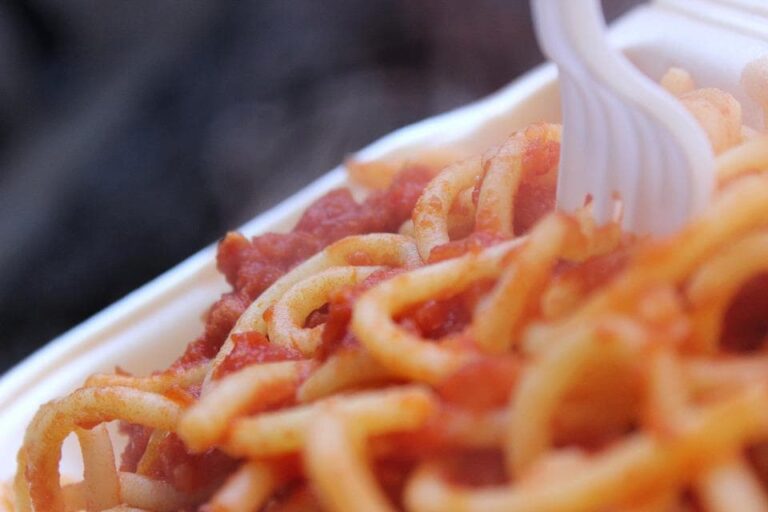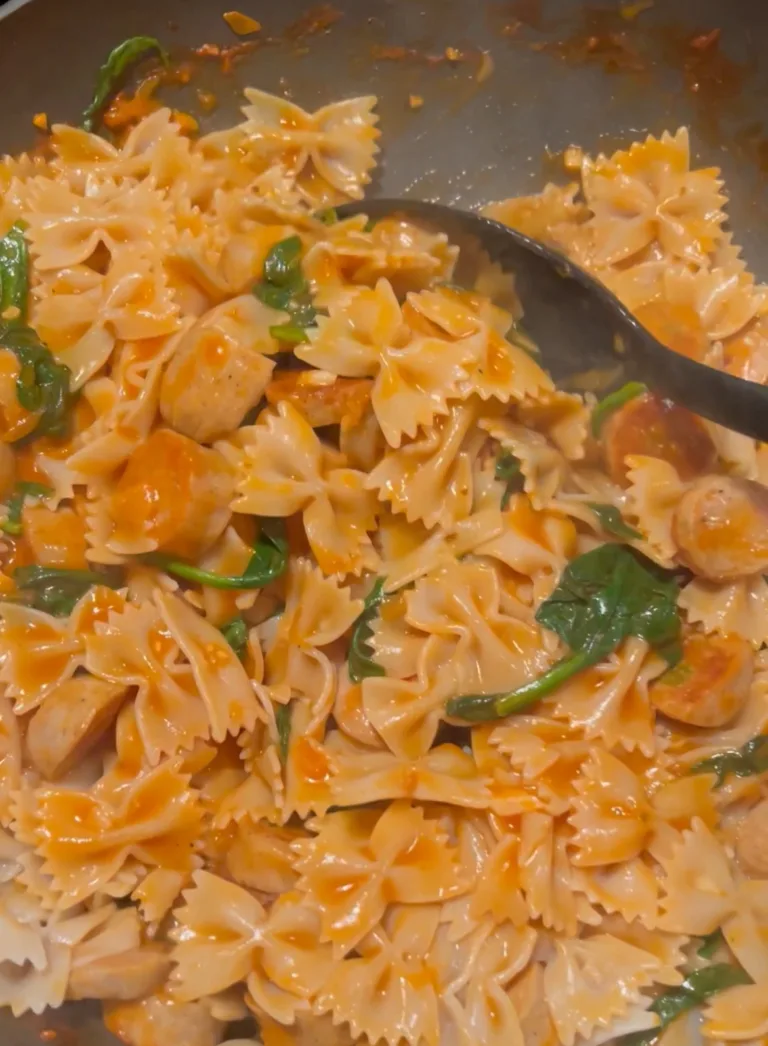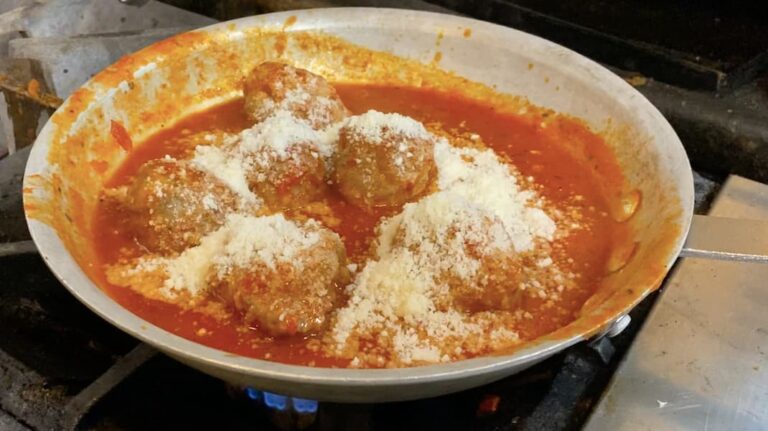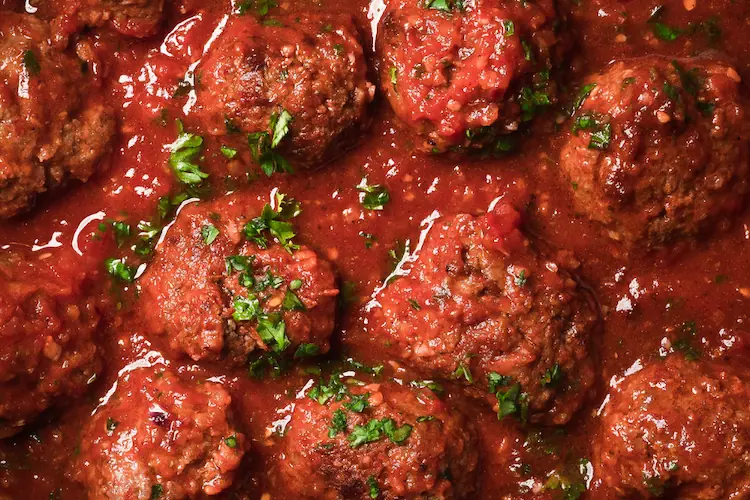Pasta all’Amatriciana is a typical food from Amatrice, a small town in the province of Rieti, Lazio. It is also known as amatriciana pasta or, simply, amatriciana – and if you ask me, it’s one of the best pasta dishes in the world.
It has everything I ask for in a pasta recipe, and is also a must-know for any food history nerd like me.
In fact, it is so important for so important to Amatrice’s history that the city’s municipality has posted the original recipe, approved by chefs and locals alike, on its website.
That recipe is the product of centuries-old traditions, and is probably the most reliable source for making authentic homemade amatriciana sauce.
Therefore, I thought I would transpose it into English for you.
Table of Contents
The history of amatriciana
If you ask anyone “what is amatriciana?“, most people will just answer that it’s a typical Roman dish. But although it is widely used in Roman cuisine, its origins are different.
Until 1927, in fact, the town of Amatrice was part of the Abruzzo region, and recipes such as amatriciana pasta, gricia, cacio e pepe, and many others were actually the foods commonly used by local shepherds.
Because of the extensive animal husbandry techniques traditionally used in those areas, these shepherds had to move miles and miles away from home for four or five months each year, in a period called “transhumance.”
Those seasonal migrations are why these recipes have spread throughout the regions of Central Italy, and also why they all share 3 key ingredients.
Having to be away from home for long periods of time, the shepherds brought with them long-life ingredients, such as pecorino cheese, guanciale, and dried pasta.
Initially, the shepherds of Amatrice used these ingredients to make mostly cacio e pepe and the dressing we know today as “Gricia” (although some locals call it “white amatriciana“).
Then in the late 18th century, the use of tomato sauce spread throughout the Kingdom of Naples (of which Amatrice was a part) and locals added it to their recipe, thus creating the red amatriciana sauce we all know today.
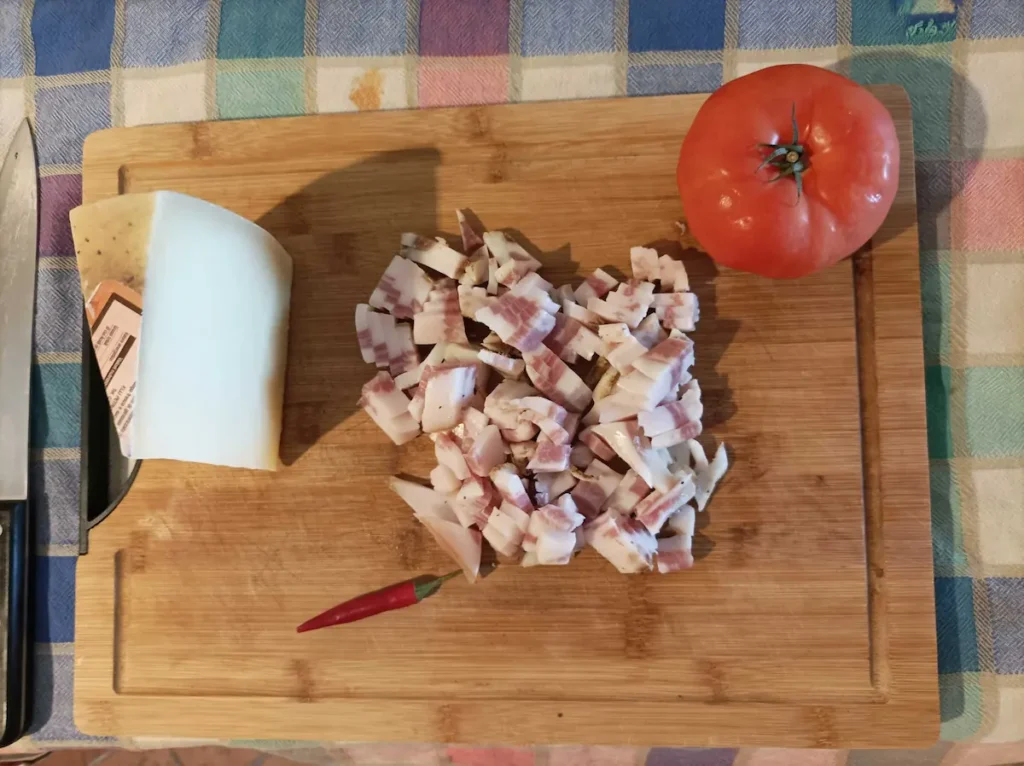
What you need
Now, let’s make an authentic, Italian-style amatriciana pasta.
Here are the ingredients that a local from Amatrice would use. Some of them are very difficult or expensive to find outside of Italy, so I’ll list some alternatives. You might not get a 100% geographically accurate amatriciana, but it will taste as good!
Spaghetti pasta: amatriciana sauce is commonly used to dress spaghetti, bucatini, rigatoni or even ridged penne. However, the recipe shared by the Comune of Amatrice calls specifically for spaghetti, so we’re going to stick to that.
Guanciale Amatriciano PGI: guanciale is a type of cured pork meat made from the pig’s jowl. It’s often mistaken with pancetta or bacon, but it has a different texture and a more intense, spicier taste. The specific type of guanciale listed in the original recipe is very difficult to find outside of Italy, but I hear that Fortuna guanciale is quite a good alternative in the US.
Note: you should always use a 1:4 ratio when buying guanciale and spaghetti. So, for 8 oz of pasta, you’re going to need 2 oz of guanciale.
One red chili pepper: possibly a Calabrian one. If you don’t have any, choose one with a similar moderate spiciness (20.000 – 30.000 SHU).
Extra-virgin olive oil: you’ll need just a tablespoon to sautee the chili pepper.
Dry white wine: you’ll add it to to a saucepan with the guanciale meat to make it even tastier.
San Marzano Tomatoes: you’ll have to boil and peel them. If you can’t find them, the recipe allows for any type of peeled tomatoes, as long as they’re good.
Pecorino Amatriciano cheese: it’s like pecorino romano, just with a different geographical provenience and a slightly less intense taste.

How to find the right cheese and guanciale?
Now, finding the specific types of guanciale and pecorino cheese listed by the Comune of Amatrice might be hard in the USA.
I’ve tried to look them up on websites that ship to the Boston area, and I could find only a very expensive form of pecorino amatriciano, and no PGI guanciale.
I’ve actually read that it couldn’t even be imported until a few years ago. And to be fair, the alternatives from Italy that I found were not very good looking.
So, I’d say it’s fair to go with alternatives like Fortuna guanciale, or with more common types of pecorino cheese. You might not get a 100% geographically accurate amatriciana sauce, but it will taste as good, without costing you a fortune.
Method
Now, first we’re going to make the amatriciana sauce, then we’ll add it to the pasta.
How to make amatriciana sauce
Step 1: cut the guanciale into small dices or strips, and add it to an iron saucepan with the chili pepper and the extra-virgin olive oil.
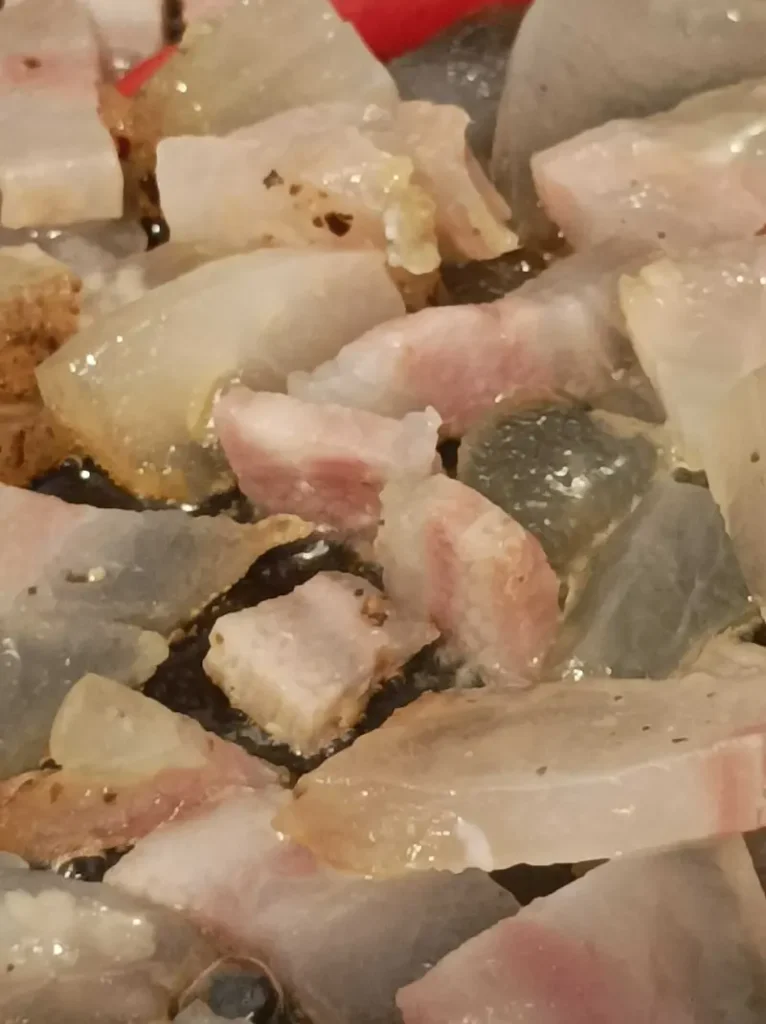
As I was saying, you don’t need a lot of olive oil. Most recipes with guanciale don’t require it at all, as the meat’s melted fat is enough to grease any saucepan. Use just a tablespoon to sautee the chili pepper.
This is also a good moment to grate the pecorino cheese and set it aside for later.
Step 2: Brown the guanciale over high heat. Add the wine and wait for it to evaporate completely.
Step 3: When the guanciale is well cooked, remove it from the pan and set aside on top of a plate covered with paper towels. Keep it warm to prevent it from drying out too much.
Step 4: Wash the San Marzano tomatoes, blanch them, peel them, cut them into strips and clean them of their seeds. After that, put them in the same pan where you cooked the guanciale, add a little salt, and cook for a few minutes until you have a nice sauce.

Step 5: Remove the chili, and put the guanciale pieces back into the saucepan, and mix well.
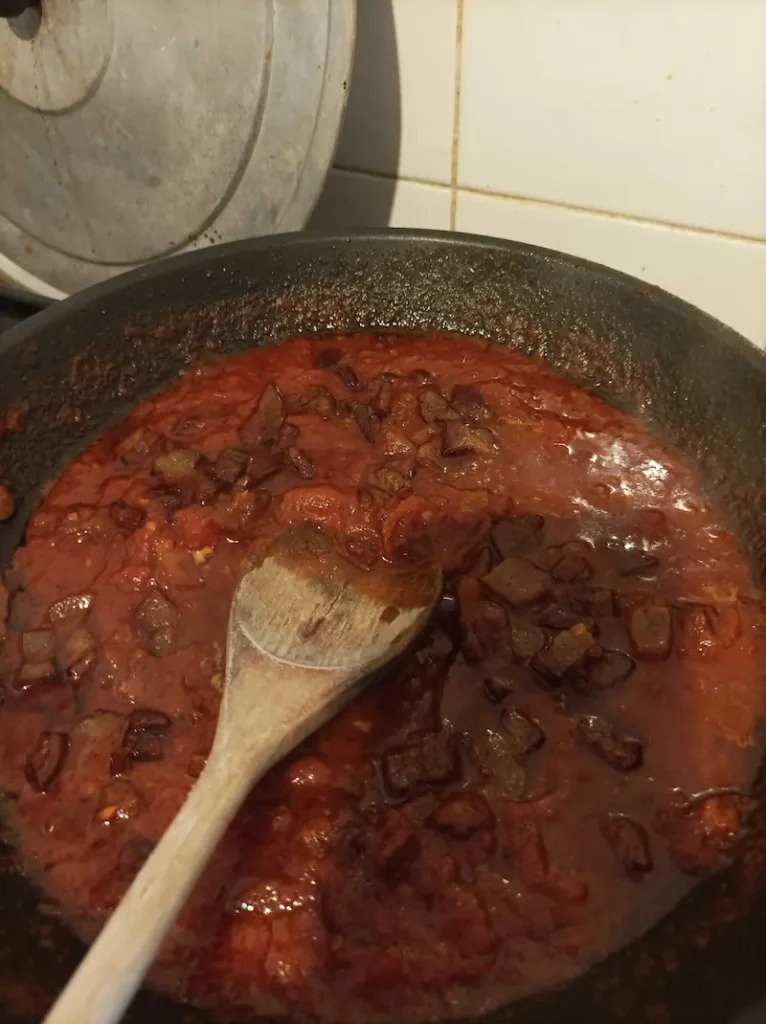
Adding the pasta
Step 6: The first thing to do is to boil the pasta al dente in salted water, and then drain it.
Step 7: Take a large bowl, and add the pasta together with the pecorino cheese. Stir well.
Step 8: Add the sauce, and give it one last stir.
Your authentic amatriciana pasta is ready. Enjoy!
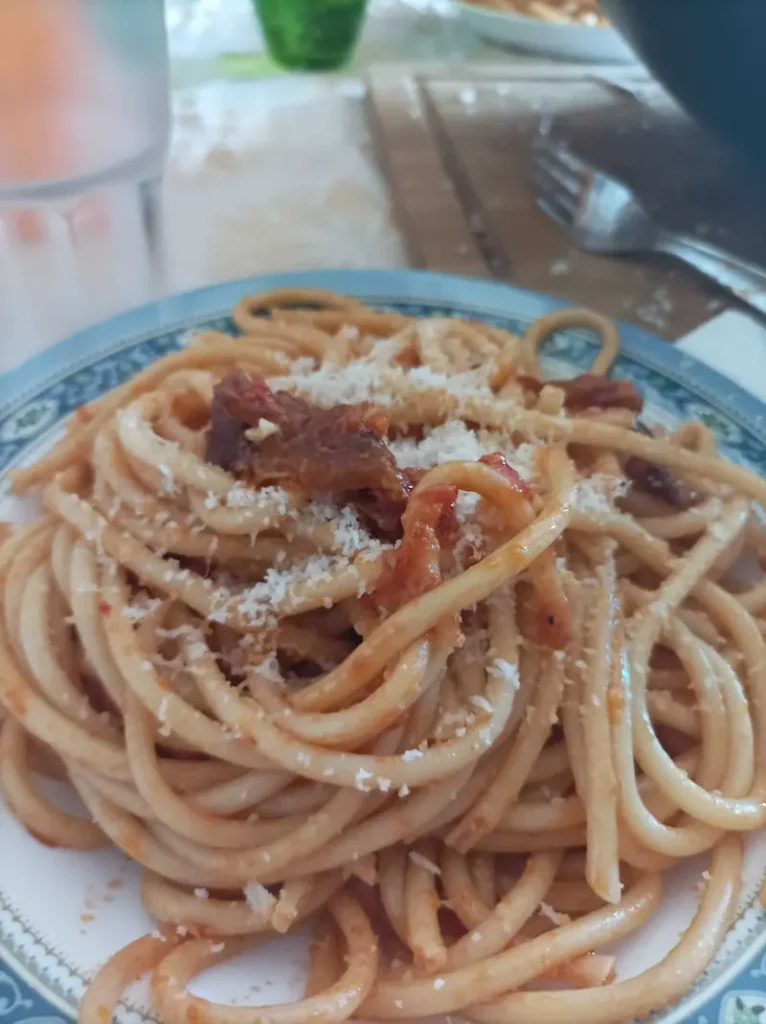
What to serve it with?
First of all, serve your amatriciana with a little extra pecorino aside. That way, your guests can choose to add some to their plate.
Second course: try serving meatballs with tomato sauce, or a meatball parmigiana. Mortadella Head’s recipe contains pecorino cheese, so it will pair nicely with your amatriciana pasta.
Side dishes: roasted potatoes will do. Alternatively, you could serve zucchini rolls stuffed with prosciutto.
Dessert: have you tried our tiramisu cup recipe yet?
Which type of wine goes best with amatriciana pasta?
Many people would recommend a full-bodied red wine, but its intense flavor may cover too much of that of the guanciale and tomato sauce.
It would be better to choose a full bodied rosee wine with good aromatic notes, such as Cerasuolo d’Abruzzo, or one made in Sicily from Nero D’Avola grapes.
Print
Authentic Amatriciana Pasta
5 Stars 4 Stars 3 Stars 2 Stars 1 Star
No reviews
- Author: Mortadella Head
- Total Time: 35 minutes
- Yield: 4 1x
Ingredients
16 oz spaghetti pasta
4 oz guanciale
7 peeled San Marzano tomatoes (or, alternatively, 14 oz peeled tomatoes)
1 hot chili pepper
3 oz grated pecorino cheese
1/4 cup of wine
1 tbsp extra-virgin olive oil
Instructions
- Cut the guanciale into small dices or strips, and add it to an iron saucepan with the chili pepper and the extra-virgin olive oil. Grate the pecorino cheese and set it aside for later.
- Brown the guanciale over high heat. Add the wine and wait for it to evaporate completely.
- When the guanciale is well cooked, remove it from the pan and set aside on top of a plate covered with paper towels. Keep it warm to prevent it from drying out too much. ù
- Wash the San Marzano tomatoes, blanch them, peel them, cut them into strips and clean them of their seeds. After that, put them in the same pan where you cooked the guanciale, add a little salt, and cook for a few minutes until you have a nice sauce.
- Remove the chili, and put the guanciale pieces back into the saucepan, and mix well.
- Boil the pasta al dente in salted water, and then drain it.
- Take a large bowl, and add the pasta together with the pecorino cheese. Stir well.
- Add the sauce, and give it one last stir.
- Enjoy!
- Prep Time: 5
- Cook Time: 30
- Category: Pasta
- Cuisine: Italian

